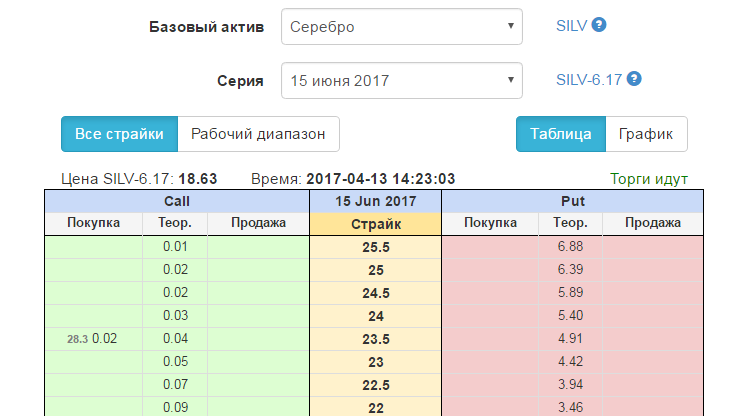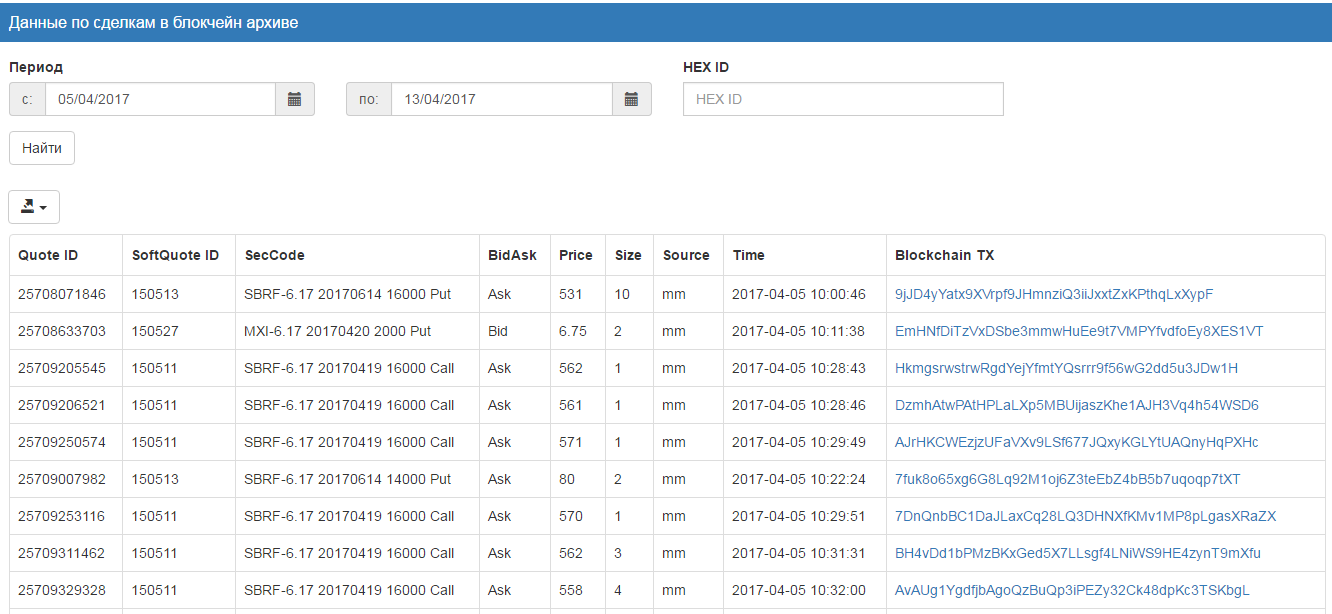OTC

Background and essence of Liquid.pro service
After the events of 2014, the relatively small Russian stock market has become even more shallow. This was largely facilitated by the withdrawal of foreign investors from the market. As a result, the volume of transactions has decreased and since then has not shown a noticeable growth. Reduction of the net profit of the Moscow stock exchange by the results of 2016 by 9.6% is an additional proof of this. The market has focused on the most liquid instruments.
Shoaling the main share market also led to a reduction in the market for derivatives, including options. This type of derivative gives option buyers the right, but not the obligation to buy or sell the product, or another asset in the future at a predetermined price. For example, in April 2017, the seller, with the help of an option, fixes the right to sell to a certain buyer dollars at a rate of 60 rubles per dollar in August 2017. As part of this scheme, the seller pays the option price in April, regardless of its final decision in August.
In addition to the exercise or non-execution of an option, the members of the exchange can buy or sell this type of derivative financial instruments to each other.
A participant in option trades can:
- Buy the right to purchase an asset;
- Sell the right to purchase the asset;
- Buy the right to sell the asset;
- Sell the right to sell the asset.
To calculate the value of an option on the market, the Black-Scholes formula is often used. The option to buy at a set price is called a call, the put option is a sell option. More details about this, as well as other types of derivative financial instruments can be read here.
Currently, two main options are most popular on the Moscow stock exchange: the ruble-dollar pair and the futures on the RTS index. While, for example, options on securities of Lukoil, Gazprom and Sberbank make up a much smaller share. With such severely narrowed demand, bids for other options other than the Ruble-Dollar pair and the RTS Index futures are not likely to be in high demand.
Restrictions are due not only to the relatively small market volume, but also to the regulations, Established by the Moscow stock exchange. According to the rules, if a market participant applies for an option, the exchange reserves a certain amount: in the case of an option, the option amount. Traders who work as a physical person are limited in amounts and can not risk the reservation on the exchange from their pockets every time, and institutional investors (banks, broker companies, etc.) are in turn limited by a rigid strategy of managing their capital.
Taking into account the current situation, the founder of Liquid.pro project, the optional trader Alexey Kalenkovich created an open platform, within which market participants can demonstrate their willingness to trade options with any strike prices – strike Which they consider appropriate based on their own trading strategies. Options for trading in the options market can be a huge variety.
For example, if a market participant believes that the value of Sberbank shares will fall within a month, he may place an order to buy an option to sell these securities (put options). In this case, the trader buys a certain number of options with a higher strike and simultaneously sells the same number of options with a lower strike. At the same time, both options must be open for the same asset – in this case for Sberbank shares, and be limited to the same term of validity. Such an option strategy is called “Bear put spread” and allows you to obtain a fixed amount of profit, if the trader’s predictions regarding the depreciation of the underlying asset turned out to be correct.
In this case, placing an order for the purchase or sale of an option on the Liquid.pro site does not require the cost of guaranteeing in the form of a reservation, as is customary on the Moscow Stock Exchange. Guarantee security is collected by the exchange only at the moment when the parties have already agreed on the terms of an option contract within the framework of the OTC trade service and confirmed the sending of an application to the exchange. The Liquid.pro platform allows participants to declare their intentions, but not to enter into deals, thus providing greater freedom in trading on the Moscow stock options market and increasing its liquidity.
All platform participants are divided into market makers and market makers. Marketmakers are users who have the right to bid on the market (quoting the market) and place orders on the platform Liquid.pro. In case of a change in the price of the underlying asset (to which the option is tied), the market maker has the right to display and remove quotes from the platform at his own discretion. Currently on the site Liquid.pro an active set of market makers is being conducted. Liquid.pro presents increased requirements to the professional competencies of this category of users. One of the market makers is the founder of the site Alexei Kalenkovich, who forms his own analytics for the market of options for market-makers.
Market-makers are the main platform participants who have the right to choose quotes of interest to them and transfer them to exchange bids after receiving confirmation of the market maker. While marketers are mostly represented by individuals, there are also participants from institutional investors.
Liquid.pro only carries an information function and does not interact directly with the Moscow stock exchange. The translation of Liquid.pro applications into exchange orders is carried out automatically due to the technological connection of the service with the merchant terminals of the participants at the API level. The opportunities for automation of interaction with the OTC service available to both market makers and marketers are listed in the API section.
What is the service for the blockbuster Waves
The decision to use blocking technology was born to the team Liquid.pro in December 2016. Before the management of the OTC trade service, the question was whether to join the existing blockhouse or create one. Liquid.pro management selected the integration of the existing distributed registry and applied to our Waves team.
Three teams took part in the work on the implementation of the detachment: Liquid.pro, Waves and a team of developers involved from outside.
The task of the blockade Liquid.pro – in the ciphered format to register all confirmed options orders sent to the Moscow stock exchange. Each operation is fixed both in the Liquid.pro system and in the public locker. Each user of Liquid.pro has an identification number. After Liquid.pro has entered its unique ID among the general list of applications sent to the Moscow stock exchange, only the applications of this user are green. The platform algorithm checks the client ID with the hashed bid in the blockroom. The ID of the platform is generated for each client automatically using the platform algorithm and therefore the uniqueness of such an identifier is guaranteed.
The concept of Liquid.pro blocking is based on the traditional exchange rule, according to which any participant can get data on the subject, date and time of all transactions . Blocker Liquid.pro allows each user to define only their applications among the general list, without the possibility to identify participants in other transactions.
Registration of any operations in public detachment is not free. Waves is no exception. The block-platform takes commission for each transaction in the amount of 0.001 Waves. For this reason, Liquid.pro management decided to register only those applications in the distributed registry that have economic meaning for the participants: they have already been sent for execution to the Moscow stock exchange. To ensure the fact of sending applications to the exchange, the consensus PoS, provided by the nodes of the Waves blockade, is used. At the same time, blocking is not used for joining applications for options between Liquid.pro users.
The record of registration of the fact of sending an application to the Moscow stock exchange is entered in the register automatically. Each participant of Liquid.pro system has the appropriate software – Connector, which interacts with payment terminals – exchange software complexes, which are used by participants of the OTC trading service. Data exchange at the software level occurs with a software package, such as QUIK, as well as with similar trading terminals. The chain looks like this: the data about the application sent to the Moscow stock exchange is transferred first from Connector to QUIK (or to the interface of a similar software package), and in parallel are registered in Waves blockade. When a participant wants to see a list of transactions, he checks against Waves using his ID.
Two separate information flows pass through the Liquid.pro site:
- Market data. Liquid.pro receives information about the market from the Moscow Stock Exchange and automatically creates a list of applications on the service.
- Data on executed applications (Execution). This flow of data goes through the market participants exhibiting and confirming applications, which are then transferred to the exchange through trading terminals and simultaneously recorded in Waves.

The block interface Liquid.pro, in which the records of applications sent to the Moscow Stock Exchange are displayed in an encrypted form, is a table with 9 columns:
- Entry Number (Quote ID);
- The order number installed by the market maker on Liquid.pro (SoftQuote ID identifier of the “soft” application);
- Name of the issuer of the underlying asset – shares (for example, SBRF or GAZR), option type (call or put), option exercise cost (strike) and option exercise date;
- Transaction type purchase or sale (Bid or Ask);
- The value of the option in rubles (Price);
- Number of options contracts within one application (Size);
- Application source (for example, mm – market maker);
- Application Time (Time) OTC;
- Hash-link to the application parameters (Blockchain TX), placed in the Waves Explorer.
We, in the team of the Waves platform, believe that block-based solutions within the Liquid.pro service can continue to evolve. In the future, OTC trading service can use the technology of the distributed registry to optimize the processes of mutual settlements between the participants of OTC traders, brokers, depositary, clearing organizations and the exchange.









